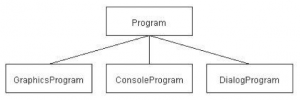The complete specification of assignment #3 can be found as part of the stream at iTunes.
Finishing up
If you’ve gotten to here, you’ve done all the hard parts. There are, however, a few more details you need to take into account:
- You’ve got to take care of the case when the ball hits the bottom wall. In the prototype you’ve been building, the ball just bounces off this wall like all the others, but that makes the game pretty hard to lose. You’ve got to modify your loop structure so that it tests for hitting the bottom wall as one of its terminating conditions.
- You’ve got to check for the other terminating condition, which is hitting the last brick. How do you know when you’ve done so? Although there are other ways to do it, one of the easiest is to have your program keep track of the number of bricks remaining. Every time you hit one, subtract one from that counter. When the count reaches zero, you must be done. In terms of the requirements of the assignment, you can simply stop at that point, but it would be nice to give the player a little feedback that at least indicates whether the game was won or lost. Continue reading “cs106a – Assignment #3 – Task #5”


